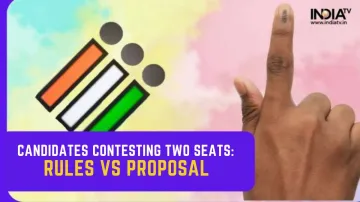In the landscape of Indian politics since independence, it's been a common practice for political leaders to contest elections from more than one seat. This is often driven by the ambition to secure a position in the Parliament or Assembly and to extend political influence. Section 33 of the Representation of the People Act, 1951, permits candidates to contest elections from a maximum of two seats, reflecting the evolving dynamics of democracy in the country. However, this practice has sparked debates regarding its fairness. Critics argue that in a system where each person is entitled to only one vote, allowing candidates to contest from more than one seat raises questions about equality and representation.
Is it fair to contest two seats simultaneously?
Leaders often contest elections on two seats simultaneously to advance their political interests. If they win both seats, they typically resign from one as per their convenience, a legal requirement. However, this practice comes at a cost to taxpayers and can negatively impact the constituents of the vacated seat. It's perceived as a manipulation of the electoral system, where elected representatives prioritise their political agendas over the interests of the electorate.
EC proposes fines to curb candidates contesting two seats
Recognizing these issues, the Election Commission has proposed penalties for candidates contesting and winning elections from two seats. The suggested fines are Rs 5 lakh for Assembly seats and Rs 10 lakh for Lok Sabha seats. The rationale behind this proposal is to make candidates accountable for the financial burden incurred by holding by-elections due to their decision to contest from multiple seats. The Election Commission aims to discourage this practice and ensure that elected representatives prioritise their constituents' interests over their own political gains.
1996 Amendment allows candidates to contest 2 seats
Before 1996, there was no fixed limit on the maximum number of seats a candidate could contest. However, the rule stipulated that a public representative could only represent one seat at a time. In 1996, an amendment to the Representation of the People Act, 1951 introduced a change, allowing candidates to contest elections on a maximum of two seats. This amendment marked a significant shift in electoral regulations, aiming to accommodate the evolving dynamics of Indian democracy.
Proposal by Election Commission
In 2004, the Election Commission made efforts to enforce the rule of one person contesting from one seat. Additionally, the Commission proposed that if the current system of candidates contesting from more than one seat is to be maintained, then those candidates should also bear the expenses of any by-elections resulting from their resignation. This proposal prompted a petition to the Supreme Court, which ultimately rejected it.
It's worth noting that recommendations for electoral reforms have been made by various committees over the years. The Dinesh Goswami Committee report in 1990 and the Law Commission's 170th report on electoral reforms, submitted in 1999, both advocated for allowing only one person to contest elections from a single constituency.
ALSO READ: Feroze Gandhi to Rahul Gandhi: Rae Bareli's tryst with Gandhi family in Lok Sabha elections | Explained
Latest India News
